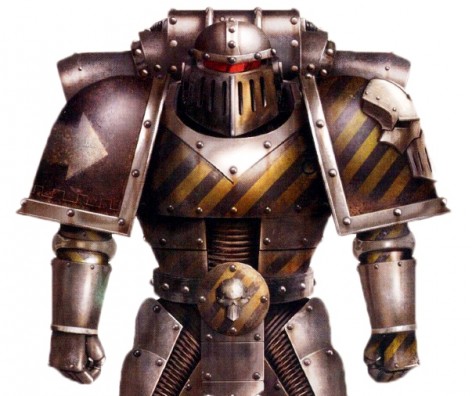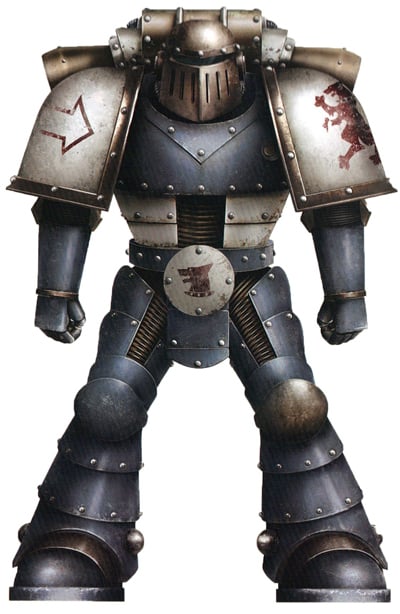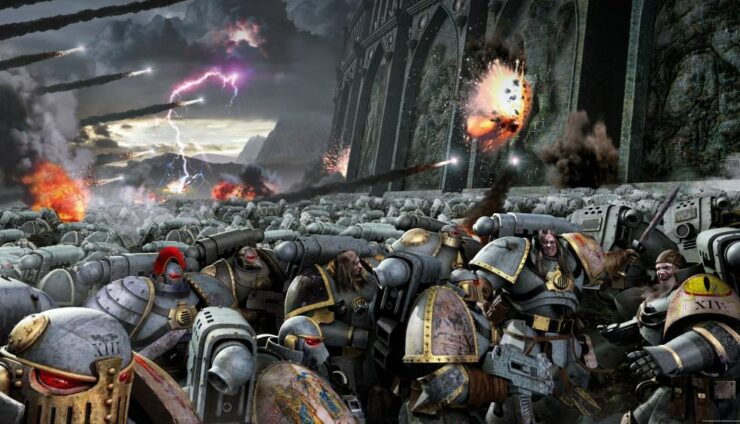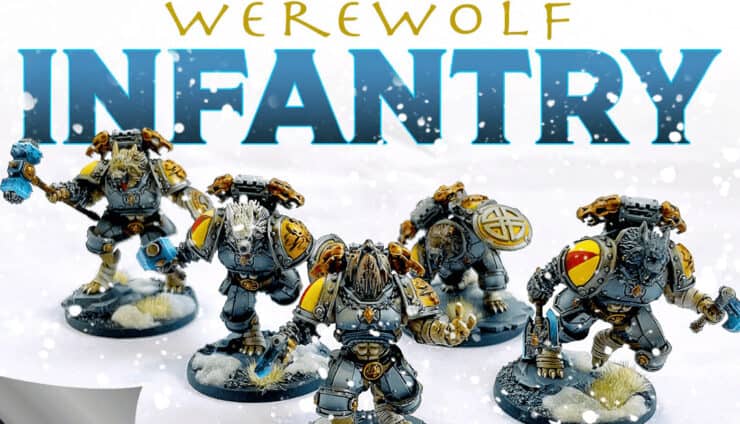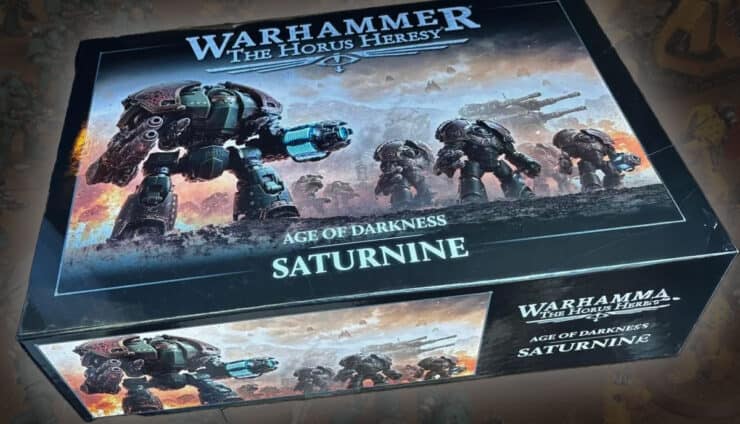Get your Horus Heresy fix with a detailed look at the Mk. II Crusade Armor! Enter, Warsmiths.
Iron Warriors Mk.II Power Armor
Via our friends at Lexicanum
Overview
Power armour is fully sealed, isolating the wearer from the outside environment and protecting him from gas weapons and harsh atmospheres. It also commonly includes numerous auxiliary systems such as communicators and auto-senses. The backpack contains the main power plant, environmental system and additional stabilizers. Whilst power armour is most commonly associated with the Adeptus Astartes, the Sisters of Battle and many Inquisitors also use powered armour of one sort or another. Typically however these armours may not contain the same strength-enhancing properties or life-support functions of Space Marine power armour, nor do they provide the same amount of protection. All armour may further be augmented by various artifacts, relics and enhancements such as pauldrons and greaves.
Power armour has been in use since before the Age of the Imperium, from the techno-barbarians of Earth to the original Space Marines created by the Emperor. Over the history of the Imperium, power armour has developed into many different forms. Need, circumstances and recovery of new materials and technology has shaped the armour’s evolution.
Space Marine Power Armour
Space Marine Power Armour is an extraordinarily sophisticated defensive system which combines huge resistance to physical damage with a sensory array and sealed environment which protects its wearer from the ravages of the void and alien atmospheres. Integrated with the armour are networks of electro-motivated fibre bundles which mimic and augment the muscular strength of the wearer. The true genius of the design, however, lies in its close integration with the already superhuman physiology, senses and reflexes of the Space Marine within. Working in concert, armour and Astartes together become a weapon without equal.
Each suit of Space Marine Power Armour is a work of supreme artisanship, and although it may be one of many, each is a unique artifact whose spirit and history is of deep spiritual significance to both the Chapter to which it belongs and the Space Marine who wears it. It can take decades to complete just one of the new Mk VII power armour, so it is often easier to make spare part for an existing suit than it is to make a completely new one.
There are numerous different Marks of Power Armour, most of which date back in terms of design and application many thousands of years ago to the time of the Great Crusade and the Horus Heresy. Each has its own lore and genesis in place and time. Even in the 41st Millennium some intact suits from this near-mythical age survive in active service as war-relics of the Space Marines. Countless others have been produced or reacquired since, and different Chapters often have entirely different panoplies they can call upon to armour their forces. It is also far from uncommon for more recently fashioned armour to incorporate slivers or whole components from far older suits as revered connections to the past.
Space Marines go through an arduous process where they receive various implants culminating with the implantation of the Black Carapace, which allows the Marine a direct and instinctual interface with the armour, making it in effect a second skin. The advanced systems of Space Marine power armour also monitor the Marine’s biological functions, feeding the medical information to the Marine.
Components
While Space Marine Armour has evolved and changed over the Millennia, key components remain the same.
- Auto-senses: Contained in the helmet, these systems include thought-activated communication arrays and audio filters, targeting reticules and range finders, tactical displays and auspex-links, and a host of other features.
- Photolenses: Protect the Space Marine from light bursts and allow him to see in the infrared and ultraviolet spectrum’s as well as enable vision in low-light conditions.
- Respirator Vox Grill: This thought-activated device amplifies a Marine’s battlecry to deafening volumes and contains a respirator to filter out toxins and draw upon an internal oxygen supply.
- Auto Responsive Shoulder Plates: Shaped to deflect and absorb incoming blows, they usually display heraldry including Chapter, Company, and Squad symbols.
- Chestpiece: Designed to protect armored power cables.
- Backpack Power Unit: This houses the primary power core for the armour, as well as reserve cells and an emergency solar collector.
- Life Signs Monitor: Regulate a suite of life support functions, including an injection system that can regulate painkillers, anti-toxins, and combat stimulants.
- Nutrient Reservoir: A self-replenishing high-energy food store that can sustain a Space Marine’s metabolism. Thus during battle, there is no need for a Space Marine to eat or drink.
- Reinforced Greaves: These incorporate gyroscopic stabilizers and power units that can magnetize the soles of the armour’s boots, allowing Space Marines to walk on metal surfaces in the void of space or zero gravity environments.
Mark 2 “Crusade Suit”
After the conquest of the main planets of the Sol system, the factories on Mars were set to work constructing a new type of armour for the Emperor’s elite Space Marines. This armoured suit is commonly referred to as “Crusade Armour,” since it was designed with the planned Great Crusade in mind, and its production led to the Thunder Armour being retroactively designated as the Mark I. It was the first fully enclosed power armour, with life-sustaining capabilities, making it suitable for combat on toxic alien planets and the depths of space.
Crusade Armour is fully plated, and the legs are also power armoured. The plates are arranged into articulated hoops, for increased maneuverability. The chest coils, which were kept on the outside of the armour plating on Mark 1 armour for cooling purposes, have now been placed on the inside of the chest plates, so that they are better protected, thanks to more efficient cooling mechanisms. However, this design could not be copied over to the new powered leg armour, which resulted in exposed cabling on the backs of the lower legs. The backpack is roughly the same size as that on the Mark I armour, but is much more efficient, and also includes extra life support, air recycling and fluid recovery equipment, as well as automated medical devices that have remained a part of Space Marine armour ever since.
The helmet is fitted with automatic sensory devices developed on Mars, which allow the wearer to see and hear as though not wearing a helmet,and, since all information is transmitted to a computer in the helmet before being transmitted directly to the wearer’s brain via neural link, it enhances sight and hearing while dampening blinding lights and deafening noises. The wearer is also able to see in the infra-red and ultra-violet spectrums, images can be zoomed in and magnified while noises can be enhanced. The helmet was fixed in a single position, but allowed the occupant to turn his head inside.
Mark II armour is believed by many to still be the most efficient example of power armour design, although with the caveat that the overlapping hooped armour plates are difficult to repair. It can still be found in operational use – in extremely limited numbers – amongst several Space Marine Chapters.
Space Marine Power Armor Marks
Which mark of power armor is your favorite?
